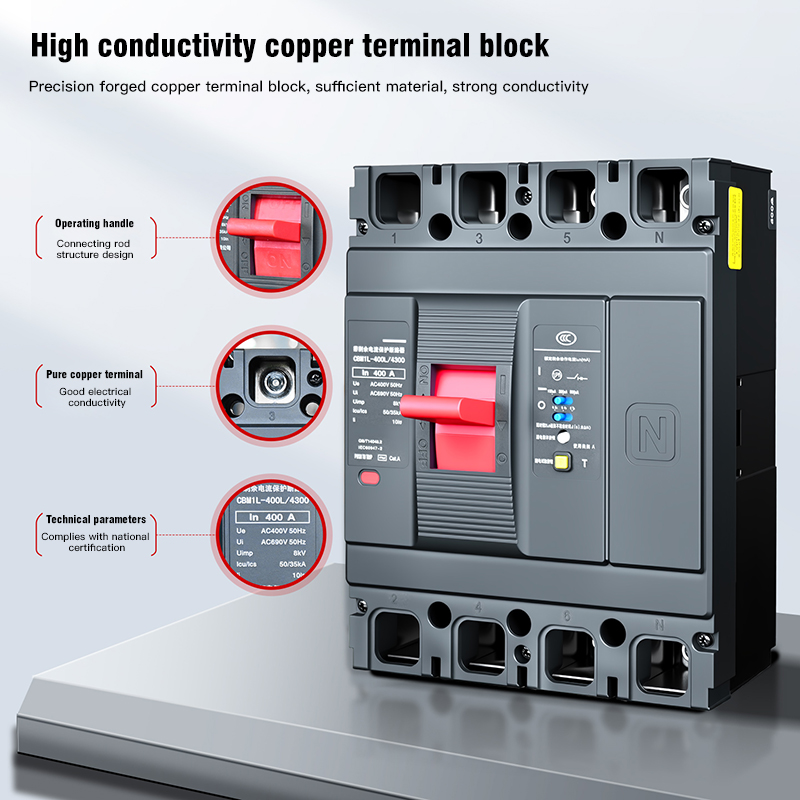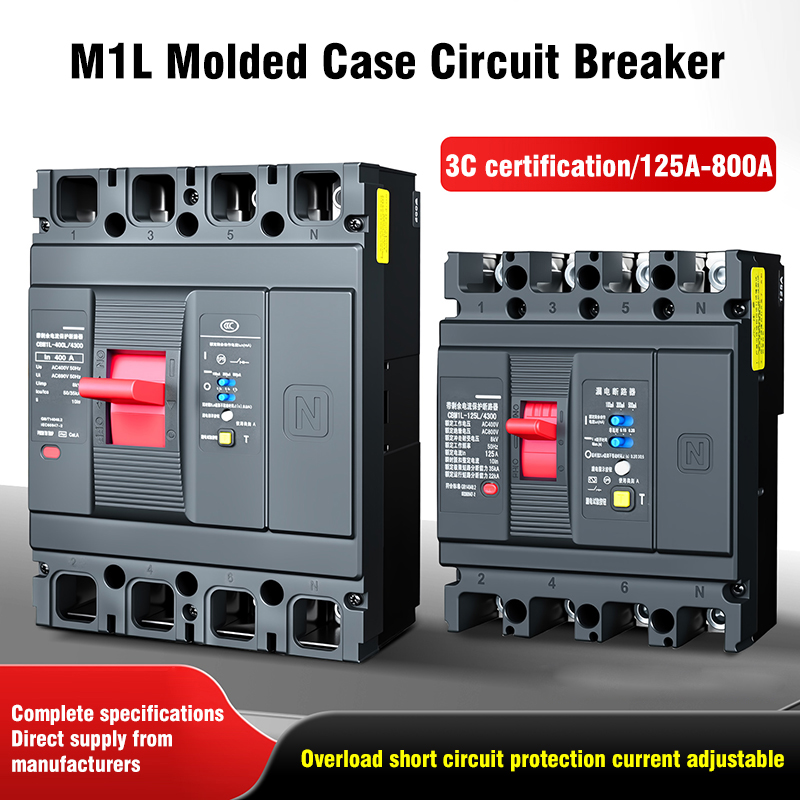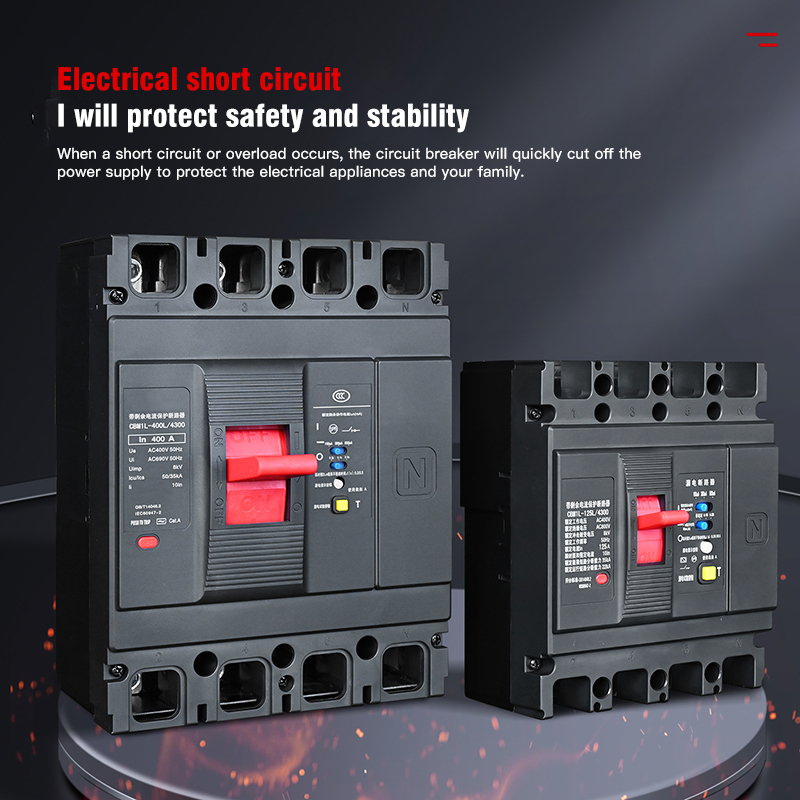In modern home and industrial power distribution systems, molded case leakage circuit breakers have long surpassed the simple understanding of "tripping means power outage." They are not merely circuit "switches," but intelligent safety hubs integrating short-circuit protection, overload protection, and leakage current warning. When current is abnormal, they can accurately identify the fault type within milliseconds and execute differentiated response strategies, truly achieving intelligent protection of "breaking when necessary and avoiding false tripping." This article will delve into the ingenious multi-layered protection logic behind them.
I. Triple Protection Mechanism: Short Circuit, Overload, and Leakage Current, Each with its Own Role
The core value of a molded case leakage circuit breaker lies in its integrated triple protection function, addressing different types of electrical risks:1. Short Circuit Protection: Rapid Disconnection to Prevent Catastrophic AccidentsA short circuit occurs when a live wire comes into direct contact with a neutral or ground wire, instantly generating a massive current of thousands of amperes. If not disconnected in time, it can burn out equipment or even cause a fire. Molded Case Leakage Circuit Breaker: The molded case leakage circuit breaker features a built-in electromagnetic tripping mechanism. When a sudden current surge to 5-10 times the rated value is detected, the electromagnetic force instantly pulls the mechanical mechanism, achieving rapid disconnection within 20 milliseconds. This effectively curbs arc propagation and protects the circuit and personal safety.2. Overload Protection: Temperature-controlled delay, balancing equipment operation and safety.Overload refers to a current that is consistently slightly higher than the rated value. While this won't immediately cause an accident, it can lead to conductor heating and insulation aging. In this case, the bimetallic strip in the circuit breaker bends due to heat, triggering tripping after a certain delay. This "inverse-time" characteristic—the greater the current, the faster the action—avoids false tripping caused by instantaneous overcurrent such as motor starting, while ensuring timely power disconnection during sustained overloads, achieving a balance between protection and use.3. Leakage Protection: Milliampere-level sensitivity, specifically designed to prevent electric shock.Leakage is the most insidious and dangerous risk. When a person accidentally comes into contact with a live conductor, or when the insulation of the circuit is damaged, causing current to leak through the ground wire or the human body, traditional circuit breakers cannot detect it. The molded case leakage circuit breaker incorporates a high-precision zero-sequence current transformer, enabling real-time monitoring of the vector sum of the live and neutral currents. Once the difference exceeds a set threshold, a leakage current is detected, and the power is cut off within ≤0.1 seconds—far faster than the critical time for ventricular fibrillation in humans, fundamentally preventing electric shock injuries and deaths.
II. Intelligent Collaboration: Not Simple Superposition, but Logical IntegrationTrue "intelligence" lies in the fact that the triple protection does not operate in isolation, but rather achieves collaborative judgment through precise mechanical and electronic design. For example:In the event of a ground fault, both short-circuit protection and leakage current may be triggered. A high-end molded case leakage circuit breaker can prioritize short-circuit tripping while simultaneously recording the leakage event for easy post-fault analysis.Some products are equipped with selective protection functions, ensuring that only the circuit breaker closest to the fault point operates in multi-level power distribution systems, preventing widespread power outages caused by cascading trips from higher levels.The new generation of products also integrates a self-testing circuit, periodically verifying whether the leakage current module is working properly and providing status feedback via indicator lights or communication interfaces, eliminating the hidden danger of "protection failure without awareness."III. Application Scenarios: Comprehensive Coverage from Home Kitchens to Industrial WorkshopsThanks to its compact molded case structure and high reliability, this type of circuit breaker is widely used in places with extremely high safety requirements:Residential: Bathrooms, kitchens, balconies, and other damp areas to prevent electrical leakage injuries;Commercial Buildings: Socket circuits in shopping malls, schools, and hospitals to ensure safety in densely populated environments;Industrial Sites: Machine tools, water pumps, temporary construction distribution boxes to cope with complex electromagnetic interference and harsh environments;New Energy Fields: Output side of photovoltaic inverters and charging pile circuits to prevent leakage risks under DC component interference.IV. Selection and Maintenance: Keeping Intelligent Protection Continuously OnlineTo maximize its effectiveness, proper selection is crucial. Users need to select appropriate rated current, breaking capacity, and leakage current action value based on factors such as load type, expected short-circuit current, ambient humidity, and whether remote monitoring is required. Meanwhile, it is recommended to press the "T" test button quarterly to verify the leakage current function. If frequent tripping occurs, the problem should be investigated by checking for aging wiring or insulation issues with the equipment, rather than simply resetting it.A molded case leakage circuit breaker is not merely a passive "trip switch," but a miniature intelligent safety system integrating sensing, judgment, and execution. It uses physical structure to implement electrical logic, protecting life and property with a millisecond response. Understanding its ingenious protection mechanism allows for more scientific use and maintenance of this "invisible guardian," ensuring peace of mind every time you use electricity.



